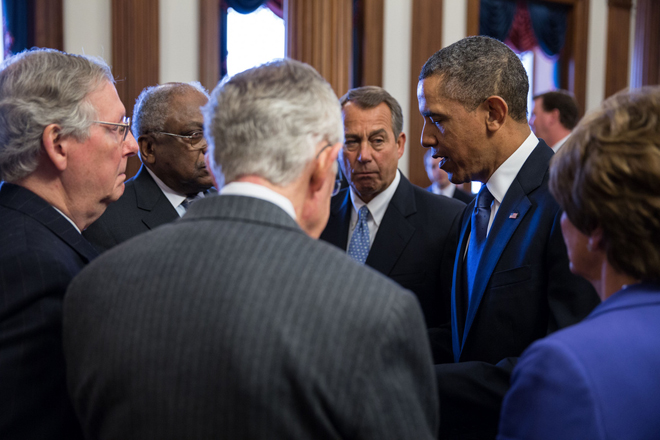A bipartisan road map to avoiding a government shutdown is emerging that involves Senate Republicans partnering with Democrats and the White House to corner the House GOP to continue the current funding levels until a broader budget accord is reached.
For it to succeed, the plan will require a handful of Senate Republicans to side with Democrats to break a filibuster and pass annual spending legislation making its way through the upper chamber. That part of the plan is already in motion — although some obstacles remain. If and when it passes, those close to the process say, the Senate and White House would have to stand firm against the House GOP’s strategy to slash domestic and poverty programs to protect the Pentagon in the hope that House Republican leaders would eventually give in and accept the framework as the Sept. 30 shutdown deadline approaches.
The big question is whether united pressure from Democrats and some Senate Republicans will be enough to force the House GOP’s hand. Given the last three years of budget brinksmanship, it’s not clear whether the House GOP will blink, although there are few tell-tale signs that some House Republicans are tiring of the politically damaging standoffs.
The White House’s demands for a debt limit framework are as follows: Don’t reduce spending below the levels agreed to under the 2011 debt limit deal (though sequestration will automatically reduce most government spending across the board) and don’t cut domestic programs like health care and research to undo military spending reductions — which are essentially what House Republicans are proposing.
“[W]e would veto the bills that cut below the sequester or try to fix the defense sequester at the expense of non-defense,” a senior White House official told TPM. But the aide dismissed as “total speculation” and “off base” a report that the White House was planning on vetoing any government funding bill that didn’t eliminate sequestration.
That means in order to keep the federal government open, the White House and Democratic leaders would be willing to accept short-term legislation that sets spending at the levels agreed to in the Budget Control Act of 2011 — and let sequestration apply to them. That leaves room for compromise with Republicans, who have vowed not to raise spending above sequester levels.
“I think the idea is that a short-term continuing resolution at current levels is tough for anyone to really say no to if the alternative is a government shutdown,” said a senior Senate Democratic aide. “And if we don’t have a deal by Sept. 30, that’s the path of least resistance.”
The plan is already in motion. Six of the 14 Republican senators on the Appropriations Committee voted with Democrats for legislation to reauthorize transportation, housing and urban development programs. Several of them strongly criticized the House GOP approach. And in an important test vote, 19 Republicans voted with all Democrats to 73-26 to advance that measure on the Senate floor late last week.
“I would ask, have members actually reviewed what is in the House transportation and housing bill?” said Sen. Susan Collins (R-ME) at recent Appropriations Committee hearing, bashing House GOP-backed cuts. “Are we to be just a rubber stamp for the House?”
The more ambitious budget goal for all parties is to reach a long-term accord, but that’s unlikely to happen by the Sept. 30 deadline. The White House, Democrats and a coalition of Senate Republicans want to eliminate the $1 trillion sequester entirely and replace it with a mix of targeted spending reductions, entitlement cuts and new revenues. But that would require House Republicans to abandon their hardline opposition to any new tax revenues. While it remains Democrats’ goal, they aren’t banking on it happening in time to avert a government shutdown; hence the stopgap of continuing resolutions to fund the government.
The Senate is currently on a collision course with the House, but House GOP leaders are signaling their awareness that a government shutdown would damage them politically. They’re working to quash a gambit by conservatives to force a government shutdown if Obamacare isn’t defunded. Facing enough pressure, Republicans leaders may similarly decide not to force a shutdown to protect the Pentagon — a strategy that is already showing signs of wear and tear.
“Shutting down the government is a suicidal political tactic,” Rep. Tom Cole (R-OK), a deputy majority whip, said Monday on MSNBC. “Now I think the big fight — the real leverage here for Republicans is the sequester. That’s a matter of law. … I think that’s where the real fight will be but again, at the end of the day, defaulting on our obligations or shutting down the government to me are not viable political options.”
This article has been updated for clarity.










